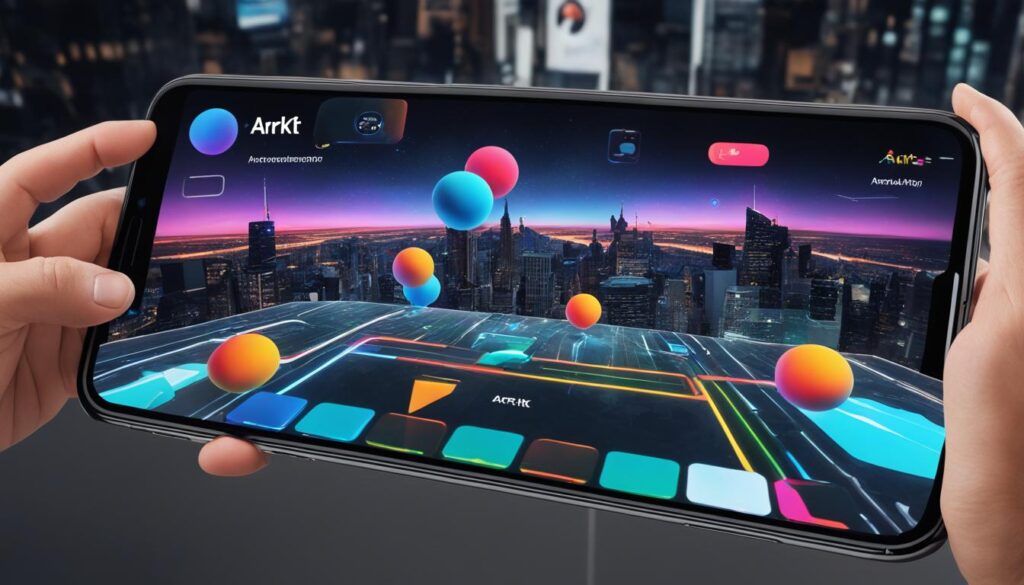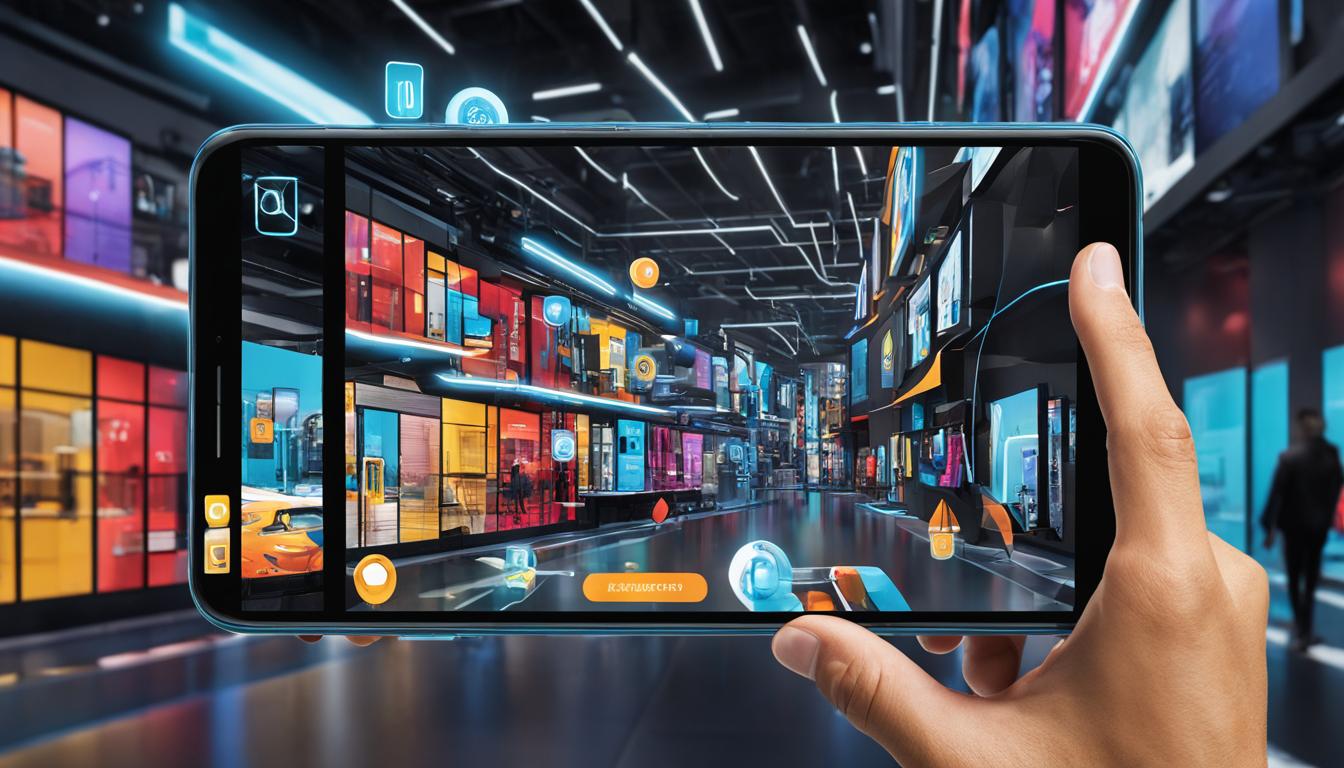Welcome to the world of augmented reality (AR), where digital experiences intersect with the real world to create immersive and interactive encounters. AR has become increasingly prevalent across various industries, from gaming and entertainment to education and marketing. But what technologies are necessary to bring AR to life? In this article, we will explore the essential tech required to implement augmented reality, providing you with a comprehensive understanding of the tools and technologies that drive this exciting field.
Contents
- 1 Mobile Augmented Reality Platforms
- 2 AR Development for iOS Devices: ARKit
- 3 AR Development for Android Devices: ARCore
- 4 Leap into the Metaverse
- 5 Conclusion
- 6 FAQ
- 6.1 What technologies are necessary for implementing augmented reality?
- 6.2 What are mobile augmented reality platforms?
- 6.3 What is ARKit and how does it contribute to AR development for iOS devices?
- 6.4 What is ARCore and how does it contribute to AR development for Android devices?
- 6.5 What is the metaverse and how does it relate to augmented reality?
- 6.6 How does artificial intelligence (AI) contribute to augmented reality?
- 6.7 What is the conclusion regarding the essential tech for implementing augmented reality?
- 7 Source Links
Key Takeaways:
- Augmented reality (AR) enhances digital experiences by overlaying virtual elements onto the real world.
- Implementing AR requires specific technologies and platforms, such as mobile devices and specialized software development kits.
- Mobile augmented reality platforms, such as smartphones, offer accessibility and portability for AR experiences.
- AR development for iOS devices leverages ARKit, providing advanced features like location anchors and LiDAR scanning.
- AR development for Android devices utilizes ARCore, which offers features like cloud anchors and AR faces.
- The concept of the metaverse and the integration of AI with AR are shaping the future of this technology.
Mobile Augmented Reality Platforms
When it comes to implementing augmented reality (AR), mobile platforms like smartphones provide a popular and accessible solution. The portability and widespread use of smartphones make them ideal for delivering AR experiences to a large consumer base.
There are three major approaches to mobile AR: native Android AR applications leveraging ARCore, native iOS AR applications utilizing ARKit, and cross-platform apps. The choice between these options depends on various factors such as device power and available features.
Native Android AR applications with ARCore offer a robust set of tools for implementing AR technology. ARCore provides essential features like motion tracking, environmental understanding, and light estimation, enabling developers to create immersive AR experiences on Android devices. Brands like Google, Snapchat, and Houzz have successfully leveraged ARCore to deliver interactive and engaging AR applications.
On the other hand, native iOS AR applications powered by ARKit offer cutting-edge capabilities for Apple devices. ARKit incorporates features like world tracking, scene understanding, and object detection, allowing developers to create realistic and interactive AR experiences on iOS devices. Brands like IKEA, MLB, and The New York Times have used ARKit to enhance their apps with AR functionality.
In addition to native development, cross-platform AR apps provide flexibility and reach across multiple mobile operating systems. Tools like Unity and Unreal Engine support cross-platform development, enabling developers to target both Android and iOS devices with a single codebase. Cross-platform AR apps are advantageous for businesses looking to reach a wide audience and maximize their AR implementation.
With mobile augmented reality platforms, businesses can leverage the power of smartphones to create immersive and engaging AR experiences. Whether it’s through native Android or iOS development, or cross-platform solutions, the necessary tools for augmented reality are readily available to businesses of all sizes.
In the next section, we will delve into the specific features and capabilities of AR development for iOS devices utilizing ARKit.
AR Development for iOS Devices: ARKit
When it comes to developing augmented reality (AR) applications for iOS devices, ARKit is a powerful and essential technology that shouldn’t be overlooked. ARKit provides a wide range of features and capabilities that enable developers to create immersive AR experiences.
One of the key technologies offered by ARKit is the ability to use location anchors. This feature allows virtual objects to be affixed to real-world locations, enhancing the sense of presence and interactivity in AR applications. With location anchors, users can explore digital content that appears to seamlessly blend with their physical surroundings.
Another important feature of ARKit is the LiDAR and depth API. This technology enables better analysis of scenes and more accurate occlusion of virtual objects. LiDAR (Light Detection and Ranging) sensors measure distances by emitting laser pulses, resulting in highly detailed depth information. This allows for more realistic and immersive AR experiences, as virtual objects can interact with the real world more accurately.
The raycasting API is yet another valuable tool provided by ARKit. This technology enhances object placement in AR applications by providing developers with the ability to cast virtual rays into the environment. By leveraging raycasting, developers can ensure precise and accurate positioning of virtual objects within the user’s surroundings.
Additionally, ARKit offers a feature called RoomPlan, which allows for quick scanning and mapping of 3D rooms. This technology enables users to create virtual representations of their physical spaces with ease, opening up possibilities for applications in interior design, real estate, and more.
ARKit is favored by developers not only for its advanced features but also for its consistency in iOS hardware. The compatibility of ARKit with Apple devices ensures that AR experiences are optimized for a wide range of iOS users, providing a seamless and reliable experience across different devices.
ARKit Features at a Glance:
| Feature | Description |
|---|---|
| Location Anchors | Enables virtual objects to be affixed to real-world locations. |
| LiDAR and Depth API | Allows for better analysis of scenes and more accurate occlusion of virtual objects. |
| Raycasting API | Enhances object placement by providing precise positioning of virtual objects. |
| RoomPlan | Enables quick scanning and mapping of 3D rooms. |
ARKit empowers developers to create captivating AR experiences on iOS devices. With its comprehensive range of features, ARKit remains one of the key technologies for implementing augmented reality, offering endless possibilities for creative and engaging applications.

AR Development for Android Devices: ARCore
When it comes to implementing augmented reality technology on Android devices, ARCore is Google’s go-to AR development platform. With its robust features and capabilities, ARCore offers businesses the tools they need to create immersive AR experiences on Android devices.
One of the standout features of ARCore is the ability to use cloud anchors. These anchors enable the placement of virtual objects in physical space with precision and accuracy, enhancing the user’s interaction with the AR environment. Whether it’s placing virtual furniture in a room or adding digital signage to a real-world location, cloud anchors provide a seamless integration of virtual and physical elements.
ARCore also includes AR faces, which allow for high-quality facial renderings in AR applications. With AR faces, businesses can create personalized experiences, such as virtual try-on for cosmetics or virtual masks for entertainment purposes. This feature enhances the realism and engagement of AR applications, making them more appealing to users.
Another useful feature of ARCore is AR images. This feature enables the implementation of augmented reality in business cards and advertising materials. By simply pointing their Android devices at an AR-enabled image, users can unlock interactive content, watch videos, or access additional information. AR images offer businesses a unique way to engage with their audience and leave a lasting impression.
Despite its impressive capabilities, it’s important to note that ARCore faces challenges when it comes to the diverse range of hardware available on Android devices. The inconsistency in hardware specifications and capabilities may affect the performance and consistency of AR experiences. Therefore, businesses should consider the capabilities of Android devices when developing AR applications to ensure optimal performance and user satisfaction.
It’s worth exploring the key features and capabilities of ARCore for implementing augmented reality technology on Android devices. By leveraging the power of ARCore, businesses can create compelling AR experiences that captivate their audience and elevate their digital interactions.
Overview of ARCore Features:
| Feature | Description |
|---|---|
| Cloud Anchors | Allows precise placement of virtual objects in physical space. |
| AR Faces | Enables high-quality facial renderings for personalized experiences. |
| AR Images | Implementation of AR in business cards and advertising materials. |
Implementing augmented reality tech on Android devices is made easier with ARCore’s versatile features and capabilities. By leveraging cloud anchors, AR faces, and AR images, businesses can create immersive AR experiences that engage users in new and exciting ways. However, the diverse range of Android device hardware must be taken into consideration to ensure consistent and optimal performance.
Leap into the Metaverse
The concept of the metaverse continues to gain attention in the augmented reality (AR) industry, offering new opportunities for businesses to create immersive experiences. By combining the virtual and physical worlds, the metaverse presents a dynamic environment where users can engage with digital content in real-time.
One of the key elements in the metaverse is the use of avatars. Avatars enable users to bring their digital personas into the real world, adding a layer of personalization and interactivity. With avatars, you can explore the metaverse as a digital representation of yourself, enhancing social interactions and expanding the possibilities of AR experiences.
In addition to avatars, spatial audio plays a crucial role in creating immersive AR experiences in the metaverse. Spatial audio enhances the sense of presence by providing realistic sounds that appear to originate from specific locations in the environment. This technology adds depth and realism to AR applications, allowing users to fully immerse themselves in the digital world.
“The metaverse offers a transformative AR experience, blurring the boundaries between the real and digital worlds. With avatars and spatial audio, businesses can create immersive experiences that captivate and engage users.”
As the metaverse continues to evolve, it holds great potential for the future of AR. Businesses can leverage this technology to create unique and interactive experiences that leave a lasting impression on their audience. Whether it’s virtual games, social platforms, or collaborative workspaces, the metaverse opens up a world of possibilities for AR implementation.
Explore the Metaverse with AR
Unlock new dimensions of augmented reality by embracing the metaverse. With avatars and spatial audio as essential tools, businesses can create immersive experiences that blur the lines between the virtual and physical worlds. As the metaverse merges with AR implementation technologies, the future of augmented reality is set to be even more extraordinary and captivating.

Advancements in AR-powered AI Applications
The combination of AI and AR has spurred the development of innovative applications. One notable example is AR-based remote collaboration, where AI-powered algorithms enable real-time object recognition and tracking during collaborative sessions. This technology is particularly valuable in remote work environments, where teams can collaborate on AR-enhanced projects, share information, and make data-driven decisions.
Another exciting advancement is the integration of AI-powered virtual assistants with AR experiences. These assistants can interpret user commands, perform complex tasks, and provide contextual information through augmented reality overlays. By seamlessly integrating AI assistants with AR, users can interact with virtual objects in a natural and intuitive manner, making AR experiences more immersive and interactive.
Summary
The integration of artificial intelligence and augmented reality is transforming the way we interact with digital content. AI’s contribution to AR technology improves the accuracy and complexity of AR experiences, leading to more realistic and engaging user interactions. The synergy between AI and AR is propelling advancements across various industries and paving the way for the future of immersive technologies.
Conclusion
As augmented reality continues to evolve, the implementation of specific technologies becomes crucial for its success. Mobile AR platforms, like smartphones, offer the accessibility and portability required for widespread adoption. For iOS devices, AR development with ARKit unlocks advanced features such as location anchors and LiDAR scanning, enabling the creation of more immersive experiences. On the other hand, AR development for Android devices with ARCore offers its unique set of features and considerations, tailored to the diversified hardware landscape.
The concept of the metaverse, which merges virtual and physical worlds, holds great potential for the future of AR. The ability to bring avatars into the real world and enhance immersion with spatial audio opens up exciting opportunities for businesses. Furthermore, the integration of artificial intelligence (AI) with AR enhances its capabilities. AI-powered facial and spatial recognition software makes AR experiences more precise, while advanced AI algorithms enable complex tasks like 3D object scanning and automatic design.
With continued advancements and improved accessibility, augmented reality has the power to transform various industries and revolutionize digital experiences. By implementing the necessary technologies and embracing the possibilities of the metaverse and AI, businesses can leverage AR to create innovative and engaging solutions, improving customer experiences and driving growth. The future of augmented reality looks promising, as it reshapes the way we interact with technology and blurs the boundaries between the physical and digital worlds.
FAQ
What technologies are necessary for implementing augmented reality?
The essential technologies for implementing augmented reality include mobile AR platforms, AR development tools like ARKit and ARCore, integration of AI with AR, and the concept of the metaverse.
What are mobile augmented reality platforms?
Mobile augmented reality platforms, such as smartphones, are popular tools for implementing AR. They offer accessibility and portability, making AR experiences widely available to consumers.
What is ARKit and how does it contribute to AR development for iOS devices?
ARKit is a powerful tool for developing AR applications on iOS devices. It offers features such as location anchors, LiDAR scanning, raycasting API, and RoomPlan. These features enhance object placement, scene analysis, and 3D room scanning for more immersive AR experiences.
What is ARCore and how does it contribute to AR development for Android devices?
ARCore is Google’s AR development platform for Android devices. It offers features like cloud anchors, AR faces, and AR images. These features enable placing virtual objects in physical space, high-quality facial renderings, and implementing AR in business cards and advertising.
What is the metaverse and how does it relate to augmented reality?
The metaverse combines virtual and physical worlds, offering new opportunities for immersive experiences. Avatars and spatial audio are examples of how AR is used in the metaverse, allowing users to bring digital personas into the real world and enhancing the immersion of AR experiences.
How does artificial intelligence (AI) contribute to augmented reality?
AI powers facial and spatial recognition software needed for AR to function. It also enables innovative solutions when combined with AR, enhancing the accuracy and complexity of AR experiences. AI and AR integration open up possibilities for advanced AR applications and improved learning experiences.
What is the conclusion regarding the essential tech for implementing augmented reality?
As augmented reality continues to evolve, the essential technologies for implementing AR include mobile AR platforms, AR development tools like ARKit and ARCore, the concept of the metaverse, and the integration of AI with AR. These technologies have the potential to transform various industries and improve digital experiences.




